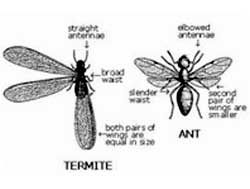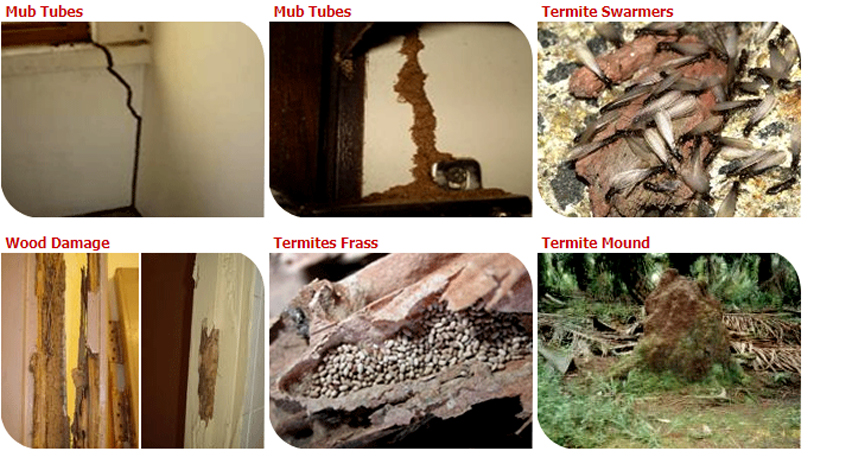
Termites are social insects living in colonies comprised of a king and a queen (wingless adults or nymphs, depending on the species), and soldiers . The king and queen perform the reproductive functions of the colony, while the workers carry on all aspects of colony maintenance. The soldiers defend the colony. These individuals, separated by divisions of labour, are referred to as castes Termites feed on wood or wood products, and their digestive tracts contain microorganisms which enable them to convert the cellulose in wood into usable food.
TERMITES VS ANTS

 Termites are often confused with ants
Termites are often confused with ants
 The termite has straight beadlike antennae, while those of ants are elbowed
The termite has straight beadlike antennae, while those of ants are elbowed
 The abdomen of the termite is broadly joined to the thorax (no waist), while the ant’s thorax and
The abdomen of the termite is broadly joined to the thorax (no waist), while the ant’s thorax and
abdomen are joined by a narrow pedicel (wasp waist)
 Termite wings, both the front and the hindwings, are of equal size. The anterior wings of the ant are considerably
Termite wings, both the front and the hindwings, are of equal size. The anterior wings of the ant are considerably
larger than the posterior wings
Drywood Termites

 Drywood termites are social insects that live in colonies in sound, dry wood
Drywood termites are social insects that live in colonies in sound, dry wood
 In comparison to other termites, drywood colonies are rather small (a few thousand individuals),
In comparison to other termites, drywood colonies are rather small (a few thousand individuals),
and the colony develops slowly
 They neither live in the ground nor maintain contact with the soil, and they do not build mud tubes
They neither live in the ground nor maintain contact with the soil, and they do not build mud tubes
 Drywood termites produce dry fecal pellets compared to subterranean termites that produce liquid feces
Drywood termites produce dry fecal pellets compared to subterranean termites that produce liquid feces
 Drywood termites tend to feed across wood grain impacting both the soft spring wood and the
Drywood termites tend to feed across wood grain impacting both the soft spring wood and the
harder summer growth
 Dead trees, branches, brush and firewood from residential areas are the primary habitat of drywood termites
Dead trees, branches, brush and firewood from residential areas are the primary habitat of drywood termites
Dampwood Termites

 Dampwood termites are found only in wood with high moisture content
Dampwood termites are found only in wood with high moisture content
 Dampwood termites do not usually infest structures because of the low moisture content of wood in structures
Dampwood termites do not usually infest structures because of the low moisture content of wood in structures
 Dampwoods are considered a minor structural pest, but they can do substantial damage if left unchecked
Dampwoods are considered a minor structural pest, but they can do substantial damage if left unchecked
 Dampwood termites produce distinctive fecal pellets that are rounded at both ends, elongate, and
Dampwood termites produce distinctive fecal pellets that are rounded at both ends, elongate, and
lack the clear longitudinal ridges common to drywood termite pellets
 Dampwood fecal pellets are often stuck together along the bottom or sides of the tunnels or may dissolve
Dampwood fecal pellets are often stuck together along the bottom or sides of the tunnels or may dissolve
into a muddy paste
 Infested wood usually shows no external damage because openings in the wood are plugged with fecal material
Infested wood usually shows no external damage because openings in the wood are plugged with fecal material
 They nest in wood buried in the ground, although contact with the ground is not necessary when
They nest in wood buried in the ground, although contact with the ground is not necessary when
infested wood is high in moisture
1. Coptotermes spp.

 Coptotermes species is one of the most destructive termites in Asia
Coptotermes species is one of the most destructive termites in Asia
 Coptotermes spesies alone is responsible for at least 80-90% of damage to human built structures,
Coptotermes spesies alone is responsible for at least 80-90% of damage to human built structures,
based on past statistics, and it is the most common termite species in all urban areas
 They have a voracious appetite for anything wood or paper, and may even attack fabric
They have a voracious appetite for anything wood or paper, and may even attack fabric
 Their nests are located deep underground
Their nests are located deep underground
 They have a large and conspicuous fontanella
They have a large and conspicuous fontanella
 They secrete a white, sticky liquid upon biting, through the fontanelle
They secrete a white, sticky liquid upon biting, through the fontanelle
2. Macrotermes spp.

 The Macrotermes genus are the largest termite species of all
The Macrotermes genus are the largest termite species of all
 Most species of Macrotermes build mounds, although there are a few subterranean species
Most species of Macrotermes build mounds, although there are a few subterranean species
 Macrotermes species are noted for having two sizes of workers and two sizes of solders
Macrotermes species are noted for having two sizes of workers and two sizes of solders
(major and minor workers and soldiers).
 The unique thing about Macrotermes termites is their fungus cultivation habit
The unique thing about Macrotermes termites is their fungus cultivation habit
 They have a large and conspicuous fontanella
They have a large and conspicuous fontanella
 They secrete a white, sticky liquid upon biting, through the fontanelle
They secrete a white, sticky liquid upon biting, through the fontanelle
3. Globitermes sulphureus

 Globitermes sulphureus is a species of termite that is very common in present in other areas of South East Asia
Globitermes sulphureus is a species of termite that is very common in present in other areas of South East Asia
 They live in nests made of earth that can be up to 1.5m tall and can contain tens of thousands of individuals
They live in nests made of earth that can be up to 1.5m tall and can contain tens of thousands of individuals
 Between 5% and 10% of the population are soldier termites which can be recognised by their yellow abdomen
Between 5% and 10% of the population are soldier termites which can be recognised by their yellow abdomen
and two large, curved mandibles
 When the nest is damaged, the soldier termites defend the nest and workers rapidly repair any
When the nest is damaged, the soldier termites defend the nest and workers rapidly repair any
damage to the nest walls
 In some cases, the contractions are so violent that the termites rupture themselves. This form of suicidal
In some cases, the contractions are so violent that the termites rupture themselves. This form of suicidal
altruism is known as autothysis
4. Microcerotermes spp.

 This species is 3.15-7.75mm long
This species is 3.15-7.75mm long
 They have long rectangular heads and long fine mandibles that are finely serrated when
They have long rectangular heads and long fine mandibles that are finely serrated when
viewed with a microscope
 Some species may build small mounds nest underground and some may make arboreal
Some species may build small mounds nest underground and some may make arboreal
nests and nest on top of posts
 Their nesting habits (mounds, arboreal nests) often betray their presence and facilitate their control
Their nesting habits (mounds, arboreal nests) often betray their presence and facilitate their control
